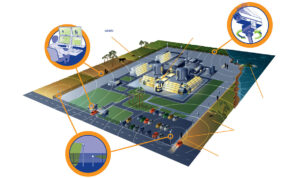
Traditionally, perimeter protection measures relied on technologies such as short distance radar, lasers, ground sensors, motion sensors or motion-sensitive fence wires. While these technologies all perform well, they have obvious and significant limitations: they do not let the operator distinguish between real and false alarms and they provide limited detail. For every alert triggered, a person has to inspect the area in question to confirm if there is an actual breach of the perimeter and a threat that needs to be dealt with. This is not only time consuming, but frequent false alarms, for instance, set off by a passing animal, can eventually lead to more lax security checks.
Recognizing how important it is to address this and to understand the nature of potential threats in real time, organizations are increasingly turning to network cameras to improve perimeter protection. Using live thermal video cameras as detection sensors and high definition video cameras to provide detail and verification, these solutions add important visual information about who or what has triggered the alarm, and about what kind of activity is going on.
The main objective of any perimeter protection system is to detect a real threat or intrusion at the earliest possible stage. However, the areas that need to be monitored can be vast – rail yards, bus depots, car parks, harbors or the area around an industrial site – and their sheer size can pose significant challenges. Lighting conditions can be a problem, especially at night time if there is little or no electric light available.
The combination of thermal cameras with intelligent video applications and pan/tilt/zoom (PTZ) dome cameras has proven very effective in handling the protection of these sites in diverse environments. Thermal network cameras do not need any light at all to operate and are an obvious solution to night monitoring. Even in broad daylight, they are useful in detecting people or objects that are obscured by complex backgrounds or deep shadows.
Fast and appropriate action
An effective perimeter protection solution needs to provide both deterrence, and immediate visual verification. The real-time information delivered by network cameras allows security staff to take quick and appropriate action, as well as minimize false alarms. In case of an incident, evidence can be collected and transferred to the relevant stakeholders by email, or as an alert on a mobile phone. Security managers can use their mobile phones to view live video from all their network cameras, or log on to the control room server to search recorded footage. The cameras can be set up to automatically trigger a response, such as floodlight or sirens, or network horn speakers can be used to issue verbal warnings.
The beauty of IP-based technologies is that they can be integrated with each other, and with existing security systems. Future-proof, flexible and fully scalable, network cameras in combination with other sensor systems and technologies such as fence or buried cable detection can cater to the most complex of setups, such as critical infrastructure protection, where the security solution has to be able to effectively manage multiple alarms at once.
The versatility of network cameras in combination with the many available video analytics applications makes these systems flexible, scalable and cost efficient. Cutting the effort, stress and problems caused by misinterpreted and false alarms will also pay dividends – if nothing else, in the form of greater peace of mind.
Source: Security Solutions Magazine



































































